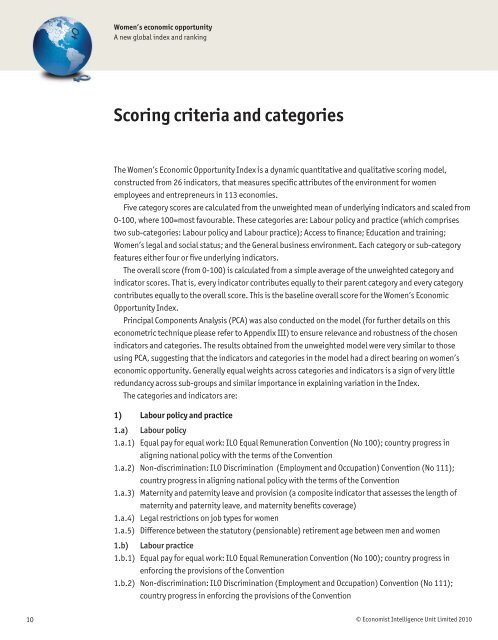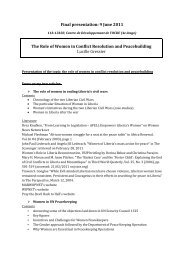Women's Economic Opportunity Index - Economist Intelligence Unit
Women's Economic Opportunity Index - Economist Intelligence Unit
Women's Economic Opportunity Index - Economist Intelligence Unit
- No tags were found...
You also want an ePaper? Increase the reach of your titles
YUMPU automatically turns print PDFs into web optimized ePapers that Google loves.
Women’s economic opportunityA new global index and rankingScoring criteria and categoriesThe Women’s <strong>Economic</strong> <strong>Opportunity</strong> <strong>Index</strong> is a dynamic quantitative and qualitative scoring model,constructed from 26 indicators, that measures specific attributes of the environment for womenemployees and entrepreneurs in 113 economies.Five category scores are calculated from the unweighted mean of underlying indicators and scaled from0-100, where 100=most favourable. These categories are: Labour policy and practice (which comprisestwo sub-categories: Labour policy and Labour practice); Access to finance; Education and training;Women’s legal and social status; and the General business environment. Each category or sub-categoryfeatures either four or five underlying indicators.The overall score (from 0-100) is calculated from a simple average of the unweighted category andindicator scores. That is, every indicator contributes equally to their parent category and every categorycontributes equally to the overall score. This is the baseline overall score for the Women’s <strong>Economic</strong><strong>Opportunity</strong> <strong>Index</strong>.Principal Components Analysis (PCA) was also conducted on the model (for further details on thiseconometric technique please refer to Appendix III) to ensure relevance and robustness of the chosenindicators and categories. The results obtained from the unweighted model were very similar to thoseusing PCA, suggesting that the indicators and categories in the model had a direct bearing on women’seconomic opportunity. Generally equal weights across categories and indicators is a sign of very littleredundancy across sub-groups and similar importance in explaining variation in the <strong>Index</strong>.The categories and indicators are:1) Labour policy and practice1.a) Labour policy1.a.1) Equal pay for equal work: ILO Equal Remuneration Convention (No 100); country progress inaligning national policy with the terms of the Convention1.a.2) Non-discrimination: ILO Discrimination (Employment and Occupation) Convention (No 111);country progress in aligning national policy with the terms of the Convention1.a.3) Maternity and paternity leave and provision (a composite indicator that assesses the length ofmaternity and paternity leave, and maternity benefits coverage)1.a.4) Legal restrictions on job types for women1.a.5) Difference between the statutory (pensionable) retirement age between men and women1.b) Labour practice1.b.1) Equal pay for equal work: ILO Equal Remuneration Convention (No 100); country progress inenforcing the provisions of the Convention1.b.2) Non-discrimination: ILO Discrimination (Employment and Occupation) Convention (No 111);country progress in enforcing the provisions of the Convention10© <strong>Economist</strong> <strong>Intelligence</strong> <strong>Unit</strong> Limited 2010




